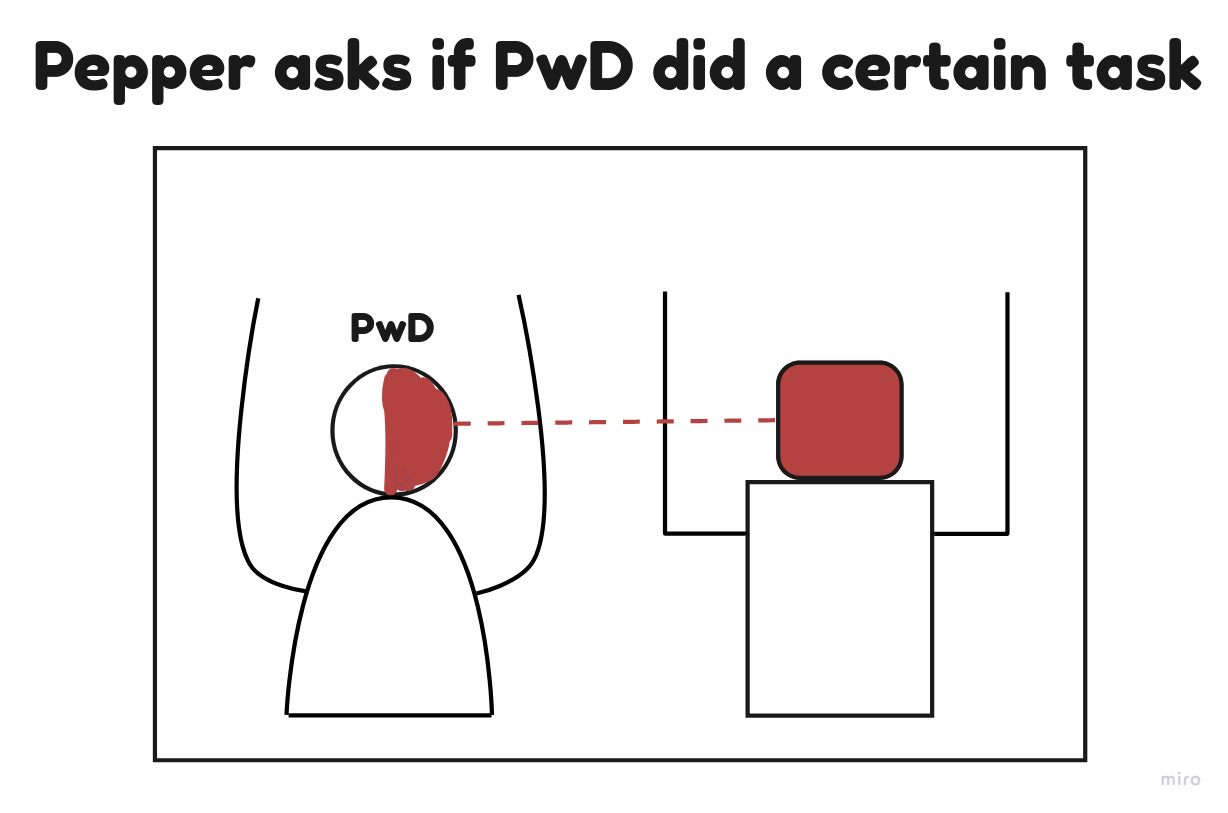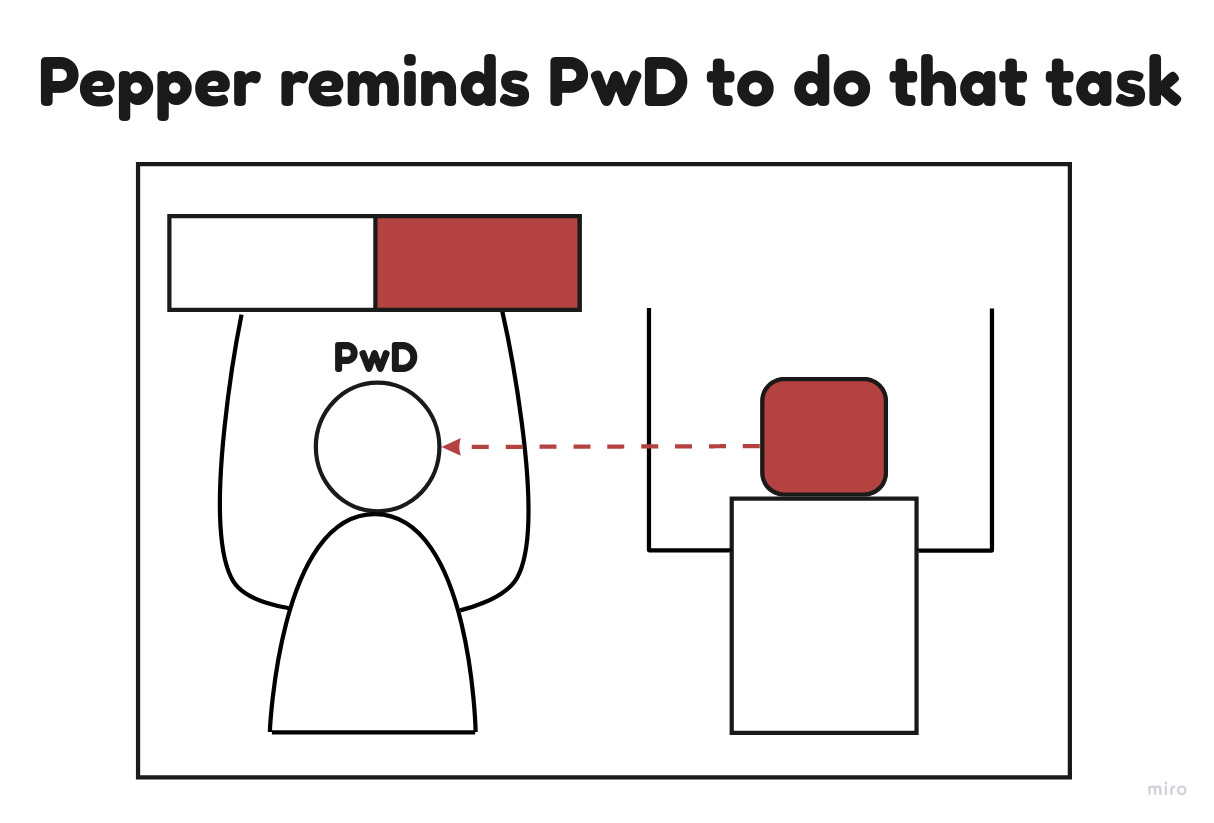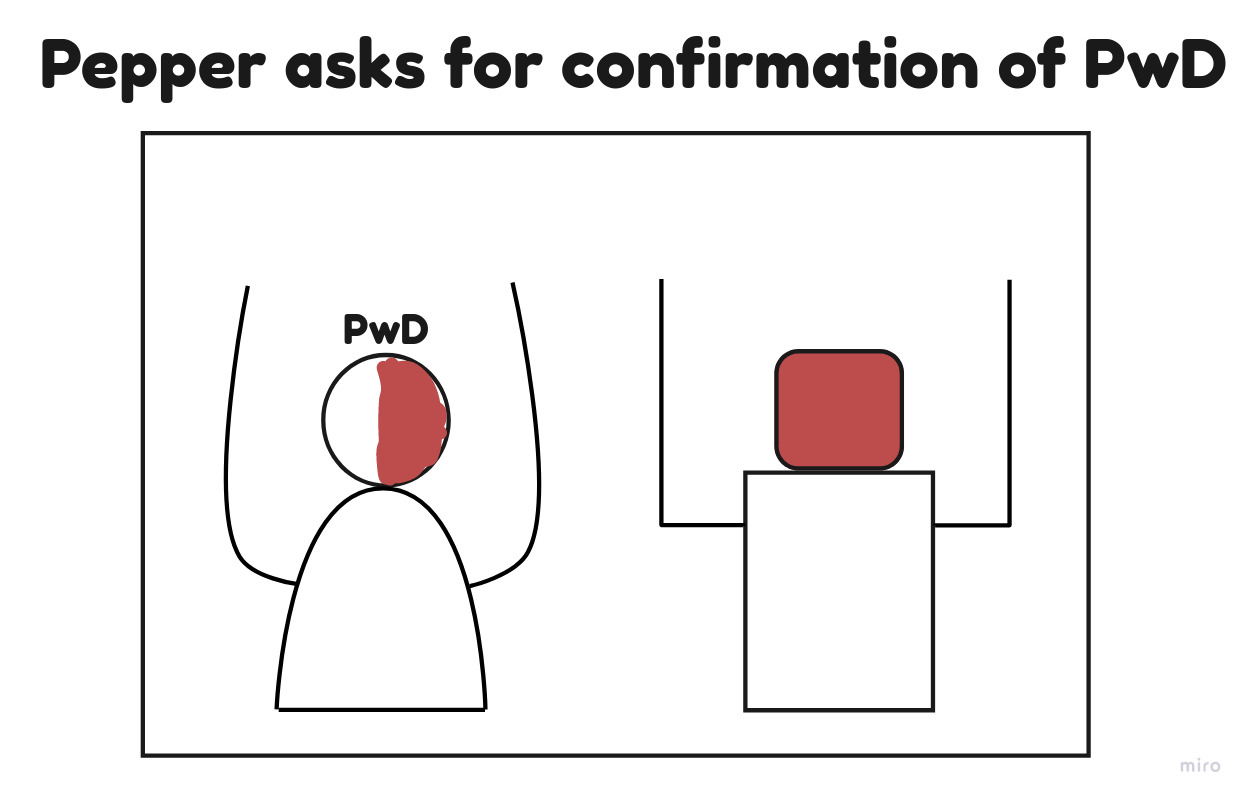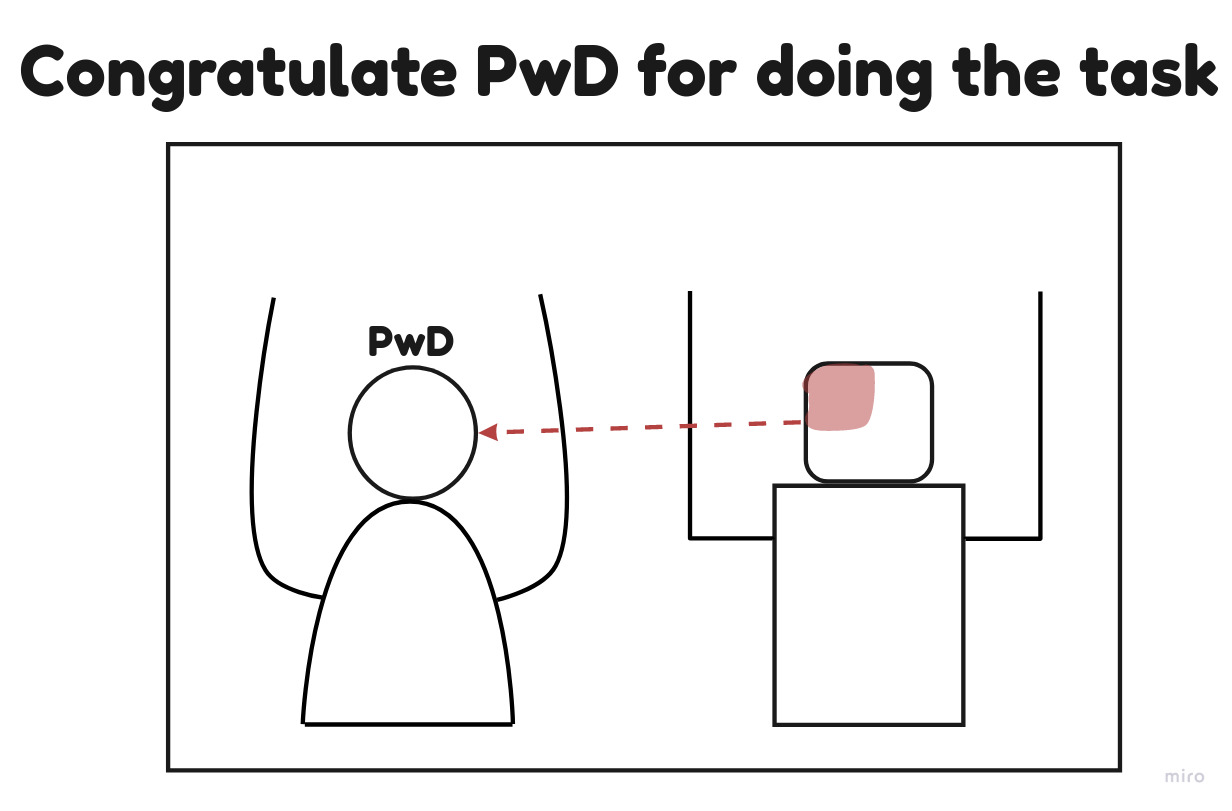Interaction Design Patterns
IDP01

RANKING/ validation | Notion of the validity (e.g., empirically tested) |
DESIGN PROBLEM (what)
| Concise description of the intended interaction (effect on the user and/or user interaction with the system and/or other parties). Here the interaction intention of the IDP is to gently remind/alert the PwD about the presence of Pepper around the room. This is in order not to startle the PwD by directly talking to them, but rather providing a gentle musical reminder of interaction about to take place. Sometimes the PwD might want to listen to some music for entertainment purposes and this IDP can also be applied in that scenario. |
CONTEXT (use when…)
| Contextual characteristics that are significant for the applicability of the pattern.
|
DESIGN SOLUTION (how)
| Essential characteristics of the design solution that express the interaction intention. This IDP contains minimal interaction, and only consists of Pepper playing music. The musical tone that will play in a specific scenario is pre-programmed for each activity. Hence the solution for gentle reminders for interaction about to happen for PwD, is to simply play some gentle reminder music. |
DESIGN RATIONALE (why)
| Argumentation that resulted in the chosen design solution. According to many studies music has shown to have a dramatic effect on people with dementia in terms of improving recollection and making them feel more calm overall. (Citations needed) Due to these researches we decided to incorporate it not only for entertainment purposes, but also for some gentle reminder purposes. |
EXAMPLES (as seen on…)
| Illustration (eg. picture, screenshot, animated graphic, video etc.) of an implementation of the design solution in a ‘real-life’ application, and include a short explanation describing the context of use. TBD (should we include or not?) |
IDP02

RANKING/ validation
| Notion of the validity (e.g., empirically tested) |
DESIGN PROBLEM (what)
| Concise description of the intended interaction (effect on the user and/or user interaction with the system and/or other parties). It is important to understand whether the PwD did a particular task or not. Tasks such as taking medicine or eating a meal are crucial, and understanding whether the PwD has successfully done this is an important first step to many reminder tasks. |
CONTEXT (use when…)
| Contextual characteristics that are significant for the applicability of the pattern. This IDP can be used in the following contexts:
|
DESIGN SOLUTION (how)
| Essential characteristics of the design solution that express the interaction intention. The solution consists of explicitly asking the PwD whether they have already performed a particular task. The response from PwD can either be yes or no, and depending on that Pepper proceeds with the next step. Simply asking the PwD whether they have performed a task is the best way to ensure a clear and concise reply which is understandable. |
DESIGN RATIONALE (why)
| Argumentation that resulted in the chosen design solution. Here instead of assessing from visual cues whether the PwD has conducted a particular task, a verbal approach is taken. This is due to Pepper's limitations in constantly being around the PwD. Although simply verbally asking whether the PwD performed a certain task might seem too straightforward, it ensures that important information is conveyed in the most explicit manner. |
EXAMPLES (as seen on…)
| Illustration (eg. picture, screenshot, animated graphic, video etc.) of an implementation of the design solution in a ‘real-life’ application, and include a short explanation describing the context of use. TBD (should we include or not?) |
IDP03

RANKING/ validation
| Notion of the validity (e.g., empirically tested) |
DESIGN PROBLEM (what)
| Concise description of the intended interaction (effect on the user and/or user interaction with the system and/or other parties). The idea of this design pattern is to verbally remind the PwD of an upcoming task. Such tasks can include medicine reminders, meal reminders etc. The intended effect on the user would be that they are reminded to do this particular task if they have not done it already. It also takes some of the burden away from primary caregivers and partners to do such a reminding job constantly. |
CONTEXT (use when…)
| Contextual characteristics that are significant for the applicability of the pattern. This IDP can be used in the following contexts:
|
DESIGN SOLUTION (how)
| Essential characteristics of the design solution that express the interaction intention. The design solution consists of Pepper reminding the PwD to do a particular task if they have not done it already. We ensure this reminder is only activated when the PwD has not performed the task in order not overwhelm them with something they have already done. The goal of the pattern is to successfully remind and encourage the PwD to perform an essential task they should do. |
DESIGN RATIONALE (why)
| Argumentation that resulted in the chosen design solution. |
EXAMPLES (as seen on…) | Illustration (eg. picture, screenshot, animated graphic, video etc.) of an implementation of the design solution in a ‘real-life’ application, and include a short explanation describing the context of use. TBD (should we include or not?) |
IDP04

RANKING/ validation
| Notion of the validity (e.g., empirically tested) |
DESIGN PROBLEM (what)
| Concise description of the intended interaction (effect on the user and/or user interaction with the system and/or other parties). This design pattern occurs hand in hand with Pepper just having told the PwD to do a certain task or activity step. The intention is to understand whether this task was successfully done by the PwD. This ensures the PwD had indeed successfully completed a certain task, which in some case may be crucial. |
CONTEXT (use when…) | Contextual characteristics that are significant for the applicability of the pattern. This IDP can be used in the following contexts:
|
DESIGN SOLUTION (how)
| Essential characteristics of the design solution that express the interaction intention. The design solution consists of Pepper asking for a verbal confirmation of having done a task. The user is prompted with a closed question such as "have you done it?," and is expected to reply in a truthful manner. Pepper will not move on unless a positive confirmation is given, in order to ensure successful completion of crucial tasks. |
DESIGN RATIONALE (why)
| Argumentation that resulted in the chosen design solution. The solution consists of explicitly asking the PwD whether they have already performed a particular task. The response from PwD can either be yes or no, and depending on that Pepper proceeds with the next step. Simply asking the PwD whether they have performed a task is the best way to ensure a clear and concise reply which is understandable. |
EXAMPLES (as seen on…) | Illustration (eg. picture, screenshot, animated graphic, video etc.) of an implementation of the design solution in a ‘real-life’ application, and include a short explanation describing the context of use. TBD (should we include or not?) |
IDP05

RANKING/ validation
| Notion of the validity (e.g., empirically tested) |
DESIGN PROBLEM (what)
| Concise description of the intended interaction (effect on the user and/or user interaction with the system and/or other parties). This design pattern occurs hand in hand with Pepper just having told the PwD to do a certain task or activity step. The intention is to understand whether this task was successfully done by the PwD. This ensures the PwD had indeed successfully completed a certain task, which in some case may be crucial. |
CONTEXT (use when…) | Contextual characteristics that are significant for the applicability of the pattern. This IDP can be used in the following contexts:
|
DESIGN SOLUTION (how)
| Essential characteristics of the design solution that express the interaction intention. The design solution consists of Pepper asking for a verbal confirmation of having done a task. The user is prompted with a closed question such as "have you done it?," and is expected to reply in a truthful manner. Pepper will not move on unless a positive confirmation is given, in order to ensure successful completion of crucial tasks. |
DESIGN RATIONALE (why)
| Argumentation that resulted in the chosen design solution. The solution consists of explicitly asking the PwD whether they have already performed a particular task. The response from PwD can either be yes or no, and depending on that Pepper proceeds with the next step. Simply asking the PwD whether they have performed a task is the best way to ensure a clear and concise reply which is understandable. |
EXAMPLES (as seen on…) | Illustration (eg. picture, screenshot, animated graphic, video etc.) of an implementation of the design solution in a ‘real-life’ application, and include a short explanation describing the context of use. TBD (should we include or not?) |